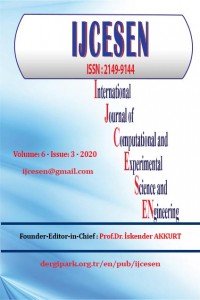Öz
Kaynakça
- [1] P. H. Kasai and D. McLeod, “Electron spin resonance study of heterocycles. I. Pyridyl radicals” J. Americ. Chem. Soc. 94,3(1972)720-727. https://doi.org/10.1021/ja00758a007
- [2] P. H. Kasai and D. McLeod, “Electron spin resonance study of heterocycles. V. Quinolyl radicals” J. Americ. Chem. Soc. 97,6 (1975) 1548-1551. https://doi.org/10.1021/ja00839a046
- [3] H. Zemel and R. W. Fessenden, “Electron spin resonance studies of phenyl and pyridyl radicals in aqueous solution” J. Physic. Chem. 79,14 (1975) 1419-1427. https://doi.org/10.1021/j100581a016
- [4] P. H. Kasai, P. A. Clark, and E. B. Whipple, “Electronic ground states of aryl radicals” J. Americ. Chem. Soc. 92,9 (1970) 2640-2644. https://doi.org/10.1021/ja00712a009
- [5] Bo-Z. Chen and Ming-B. Huang, "Hyperfine structure in HCS and related radicals: a theoretical” Chem. Phys. Lett. 308, 3-4 (1999) 256-262. https://doi.org/10.1016/S0009-2614(99)00601-6
- [6] T. Wang, F. M. Tang and Y. F. Wu, “A combined EPR and DFT study of the overcrowded aromatic radical cations from Friedel–Crafts alkylation reactions” J. Mol. Struct. 1002,1-3 (2011). 128-134. https://doi.org/10.1016/j.molstruc.2011.07.009
- [7] N. Ishii and T. Shimizu, “Density-functional-theory calculations of isotropic hyperfine coupling constants of radicals” Chem. Phys. Lett. 225,4-6 (1994). 462-466. https://doi.org/10.1016/0009-2614(94)87112-4
- [8] L. Hermosilla, G. Vega, C. Sieiro, and P. Calle, “DFT Calculations of Isotropic Hyperfine Coupling Constants of Nitrogen Aromatic Radicals: The Challenge of Nitroxide Radicals” J. Chem. Theory Comput. 7, 1 (2011) 169-179. https://doi.org/10.1021/ct1006136
- [9] Ş. Nardali, F. Ucun and M. Karakaya, “Calculated hyperfine coupling constants for 5,5-dimethyl-1-pyrroline N-oxide radical products in water and benzene” Russian J. Phys. Chem. A (2017) 91, (2017) 2137-2148. https://doi.org/10.1134/S0036024417110164
- [10] F. Ucun and S.G. Aydın, “Calculated optimized structures and hyperfine coupling constants of some radical adducts of α-phenyl-N-tert-buthyl nitrone in water and benzene solutions” J. Organomet. Chem. 759, (2014). 27-32. https://doi.org/10.1016/j.jorganchem.2014.02.011
- [11] M. J. Frisch, G. W. Trucks, H. B. Schlegel, et al., Gaussian 09, Revision D.01 (Gaussian, Inc., Pittsburgh, PA, 2009). https://gaussian.com/g09citation/
- [12] R. Dennington, T. Keith and J. Millam, GaussView, Version 5.0.9, (Semichem Inc., Shawnee Mission: KS, 2009). https://gaussian.com/g09citation/
- [13] J. E Bennett and B. Mile “Electron Spin Resonance Spectra of Some -Type Aromatic Radicals” The J. Phys. Chem. 75, 22 (1971) 3423,3437. https://doi.org/10.1021/j100691a005
Öz
The hyperfine coupling constants of some type radicals were calculated by using the DFT(B3LYP) method with LanL2DZ basic set. These are phenyl, naphthyl, pyridyl, and quinolyl radicals. Also, the study was enriched by the calculations of the spin densities for all the radicals. From the results it was concluded that the spin density of the unpaired electron is mainly in one sp-hybrid orbital of the carbon atom from which hydrogen is removed. The electron paramagnetic resonance (EPR) spectra of all the radicals are generally based on the hyperfine splittings belonging to only the close hydrogen or azote atoms of the benzene ring to the unpaired electron since the effect of the other atoms is disappeared in the linewith of the EPR spectrum lines. The EPR spectra were also simulated by using their calculated isotropic hyperfine coupling constants and, compared with the experimental data. It was found a good agreement beetwen them.
Anahtar Kelimeler
Hyperfine Constant EPR Radical Density Functional Theory Simulation
Kaynakça
- [1] P. H. Kasai and D. McLeod, “Electron spin resonance study of heterocycles. I. Pyridyl radicals” J. Americ. Chem. Soc. 94,3(1972)720-727. https://doi.org/10.1021/ja00758a007
- [2] P. H. Kasai and D. McLeod, “Electron spin resonance study of heterocycles. V. Quinolyl radicals” J. Americ. Chem. Soc. 97,6 (1975) 1548-1551. https://doi.org/10.1021/ja00839a046
- [3] H. Zemel and R. W. Fessenden, “Electron spin resonance studies of phenyl and pyridyl radicals in aqueous solution” J. Physic. Chem. 79,14 (1975) 1419-1427. https://doi.org/10.1021/j100581a016
- [4] P. H. Kasai, P. A. Clark, and E. B. Whipple, “Electronic ground states of aryl radicals” J. Americ. Chem. Soc. 92,9 (1970) 2640-2644. https://doi.org/10.1021/ja00712a009
- [5] Bo-Z. Chen and Ming-B. Huang, "Hyperfine structure in HCS and related radicals: a theoretical” Chem. Phys. Lett. 308, 3-4 (1999) 256-262. https://doi.org/10.1016/S0009-2614(99)00601-6
- [6] T. Wang, F. M. Tang and Y. F. Wu, “A combined EPR and DFT study of the overcrowded aromatic radical cations from Friedel–Crafts alkylation reactions” J. Mol. Struct. 1002,1-3 (2011). 128-134. https://doi.org/10.1016/j.molstruc.2011.07.009
- [7] N. Ishii and T. Shimizu, “Density-functional-theory calculations of isotropic hyperfine coupling constants of radicals” Chem. Phys. Lett. 225,4-6 (1994). 462-466. https://doi.org/10.1016/0009-2614(94)87112-4
- [8] L. Hermosilla, G. Vega, C. Sieiro, and P. Calle, “DFT Calculations of Isotropic Hyperfine Coupling Constants of Nitrogen Aromatic Radicals: The Challenge of Nitroxide Radicals” J. Chem. Theory Comput. 7, 1 (2011) 169-179. https://doi.org/10.1021/ct1006136
- [9] Ş. Nardali, F. Ucun and M. Karakaya, “Calculated hyperfine coupling constants for 5,5-dimethyl-1-pyrroline N-oxide radical products in water and benzene” Russian J. Phys. Chem. A (2017) 91, (2017) 2137-2148. https://doi.org/10.1134/S0036024417110164
- [10] F. Ucun and S.G. Aydın, “Calculated optimized structures and hyperfine coupling constants of some radical adducts of α-phenyl-N-tert-buthyl nitrone in water and benzene solutions” J. Organomet. Chem. 759, (2014). 27-32. https://doi.org/10.1016/j.jorganchem.2014.02.011
- [11] M. J. Frisch, G. W. Trucks, H. B. Schlegel, et al., Gaussian 09, Revision D.01 (Gaussian, Inc., Pittsburgh, PA, 2009). https://gaussian.com/g09citation/
- [12] R. Dennington, T. Keith and J. Millam, GaussView, Version 5.0.9, (Semichem Inc., Shawnee Mission: KS, 2009). https://gaussian.com/g09citation/
- [13] J. E Bennett and B. Mile “Electron Spin Resonance Spectra of Some -Type Aromatic Radicals” The J. Phys. Chem. 75, 22 (1971) 3423,3437. https://doi.org/10.1021/j100691a005
Ayrıntılar
| Birincil Dil | İngilizce |
|---|---|
| Bölüm | Research Articles |
| Yazarlar | |
| Yayımlanma Tarihi | 30 Kasım 2020 |
| Gönderilme Tarihi | 10 Haziran 2020 |
| Kabul Tarihi | 10 Kasım 2020 |
| Yayımlandığı Sayı | Yıl 2020 Cilt: 6 Sayı: 3 |

